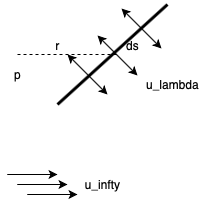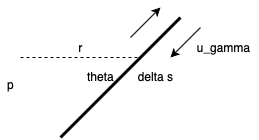20.5 Panel Method#
Panel methods are a classical approach to solving flow problems that is still very useful today when finding solutions to even very complicated geometries. You represent a body as a series of panels.
A few definitions first: we say a source panel of strength \( \lambda \) (units m/s) is defined by:
\[\phi_p = \frac{1}{2 \pi} \int \lambda \ln (r) \dd s\] \[= \frac{1}{2 \pi} \int \lambda \ln \left( \sqrt{ (x_p - x)^2 + (y_p - y)^2}\right) \dd s\] \[\lambda = 2 u_\lambda\]
So, at each panel \( i \) the normal velocity comes from the contribution from the panel, the contribution from all other panels, and this must equal the free flow normal \( - u_{\infty} \cos \beta_i \)
\[\frac{\lambda_i}{2} + \sum_{j \neq i} \frac{\lambda_j}{2 \pi} \int _j \pdv{}{n_i} \ln ( r_{i j}) \dd s_j = - u_{\infty} \cos \beta_i\]This gives N equations and N unknowns (\( \lambda_i \)). We can solve them to compute
\[u_{t_{i}} = \frac{\lambda_i}{2} \tan \beta _i\] \[\phi(x, y) = \sum_i \phi_i (x, y) \rightarrow \vec v = - \grad \phi\]This method is applicable for non-lifting bodies. Without circulation (vertices) there can’t be any lift. We can modify the model by including a term that corresponds with circulation, we can allow for lift.
Define a distributed vortex panel of strength \( \gamma \) (units m/s):
\[\gamma = \lim_{\Delta s \rightarrow 0} \frac{1}{\Delta s} \oint \vec v \cdot \dd \vec l = 2 u_{\gamma}\] \[\dd v = \frac{\gamma \dd s}{2 \pi r}\] \[\phi _p = \frac{1}{2 \pi} \int \gamma \dd s \theta = \frac{1}{2 \pi} \tan ^{-1} \left( \frac{y_p - y}{y_p - x} \right) \gamma \dd s\]
This gives N unknowns \( \gamma_i \) and only N-1 equations. The last equation comes from the Kutta condition, which says that the tangential velocity at the trailing edge has to be the same from the top as from the bottom of the airfoil. That is to say, the flow must detach at the trailing edge:
\[u_{t_1} = - u_{t_N}\]Once we’ve solved for \( \gamma_i \) and \( \lambda_i \) we can compute what the flow velocity is
\[u_{t_i} = \frac{\lambda_i}{2} \tan \beta_i + \frac{\gamma_i}{2} + \sum_{j \neq i} \frac{\gamma_j}{2 \pi} \int \pdv{}{t_i} \left[ \tan ^{-1} \left( \frac{y_i - y_j}{x_i - x_j} \right) \right] \dd s _j\] \[\phi(x, y) = \sum_i \phi_i (x, y) \rightarrow \vec v(x, y) = - \grad \phi\]The coefficient of pressure is
\[C_p = \frac{p - p_{\infty}}{\frac{1}{2} \rho u_{\infty}^2} = 1 - \frac{u_t ^2}{u_\infty ^2}\]